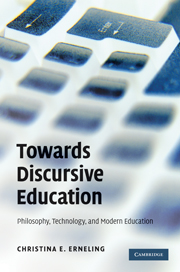Book contents
- Frontmatter
- Contents
- Acknowledgements
- Introduction
- 1 The infantilisation of learning
- 2 Educational technologies and pedagogy
- 3 Piaget and natural learning
- 4 Piaget's conception of the framework: from instincts to intentionality
- 5 The infant as scientist
- 6 The socio-cultural approach to learning
- 7 Towards discursive education
- Appendix
- References
- Index
4 - Piaget's conception of the framework: from instincts to intentionality
Published online by Cambridge University Press: 05 June 2012
- Frontmatter
- Contents
- Acknowledgements
- Introduction
- 1 The infantilisation of learning
- 2 Educational technologies and pedagogy
- 3 Piaget and natural learning
- 4 Piaget's conception of the framework: from instincts to intentionality
- 5 The infant as scientist
- 6 The socio-cultural approach to learning
- 7 Towards discursive education
- Appendix
- References
- Index
Summary
INTRODUCTION
Natural learning theories approach the second problem of learning, that is, the problem of the framework, in fundamentally the same way as they approach that of productivity: by focusing on individual, biologically grounded mental states and processes. In order to learn something and to go beyond experience and the information given, the child has to be able to make sense of what he or she encounters, sort out the irrelevant from the relevant, and make it fit with what is already known. What is to be learned has to be meaningful to the learner. This is the case whether productivity is defined as a product of induction, deduction, or what Piaget calls assimilation and accommodation. In order to learn something, the learner has to have a meaningful framework into which new experiences are fitted. How is this basic framework, which enables all subsequent learning, acquired? How do natural learning theories account for this? Again, my discussion focuses on Piaget, but before turning to a discussion of his ideas, some general points about mental activity and meaning need to be made. I shall also briefly mention Chomsky's solution to the problem of the framework. Since the same criticisms that I use to evaluate Piaget's views can be used to assess Chomsky's basic assumption, I shall not repeat them again here.
- Type
- Chapter
- Information
- Towards Discursive EducationPhilosophy, Technology, and Modern Education, pp. 92 - 108Publisher: Cambridge University PressPrint publication year: 2010



